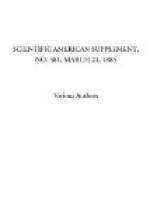* * * * *
THE CHINESE PUMP.
If a glass tube about three feet in length, provided at its upper extremity with a valve that opens outwardly, and at its lower with one that opens inwardly, be dipped into water and given a series of up and down motions, the water will be seen to quickly rise therein and finally spurt out at the top. The explanation of the phenomenon is very simple. Upon immersing the tube in the water it fills as far as to the external level of the liquid, and the air is expelled from the interior. If the tube be suddenly raised without removing its lower extremity from the water, the valve will close, the water will rise with the tube, and, through the velocity it has acquired, will ascend far above its preceding level. Now, upon repeating the up and down motion of the tube in the water five or six times, the tube will be filled, and will expel the liquid every time that the vertical motion occurs.
[Illustration: The Chinese pump.]
We speak here of a glass tube, because with this the phenomenon may be observed. Any tube, of course, would produce the same results.
The manufacture of the apparatus is very simple. The tube is closed above or below, according to the system one desires to adopt, by means of a perforated cork. The valve is made of a piece of kid skin, which is fixed by means of a bent pin and a brass wire (Fig. 2). It is necessary to wet the skin in order that it may work properly and form a hermetic valve. The arrangement of the lower valve necessitates the use of a tube of considerable diameter (Fig. 1). We would advise the adoption of the arrangement shown in Fig. 2. Under such circumstances a tube half an inch in diameter and about 3 feet in length will answer very well.
It is better yet to simply use one’s forefinger. The tube is taken in the right hand, as shown in Fig. 3, and the forefinger placed over the aperture. The finger should be wetted in order to perfect its adherence, and should not be pressed too hard against the mouth of the tube. It is only necessary to plunge the apparatus a few inches into the liquid and work it rapidly up and down, when the water will rise therein at every motion and spurt out of the top.
This is an easy way of constructing the Chinese Pump, which is found described in treatises upon hydraulics. Such a pump could not, of course, be economically used in practice on account of the friction of the column of water against a wide surface in the interior of the tube. It is necessary to consider the pistonless pump for what it is worth—an interesting experimental apparatus that any one can make for himself.—La Nature.
* * * * *
THE WATER CLOCK.
To the Editor of the Scientific American:




